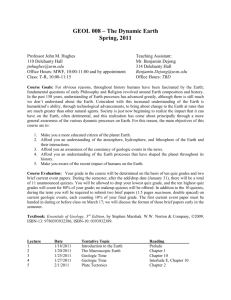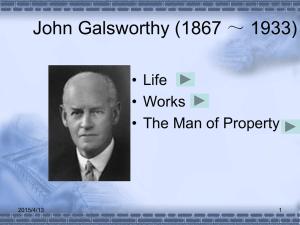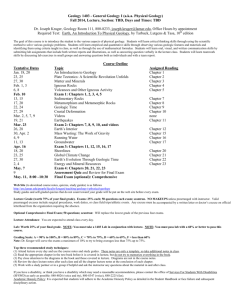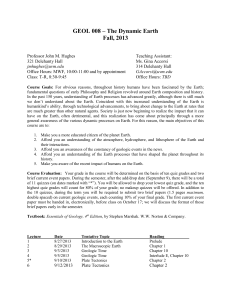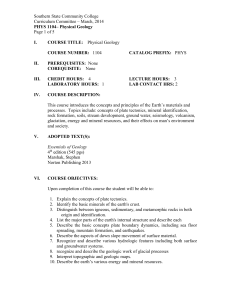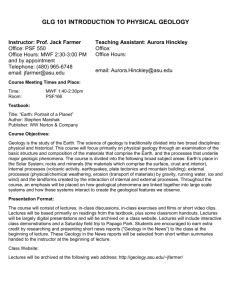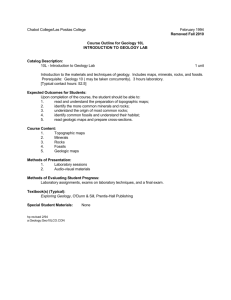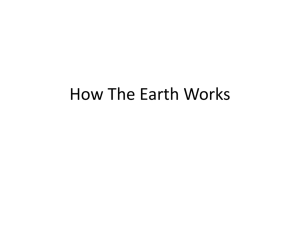COURSE OUTLINE: GEOLOGY 101, Physical Geology
advertisement
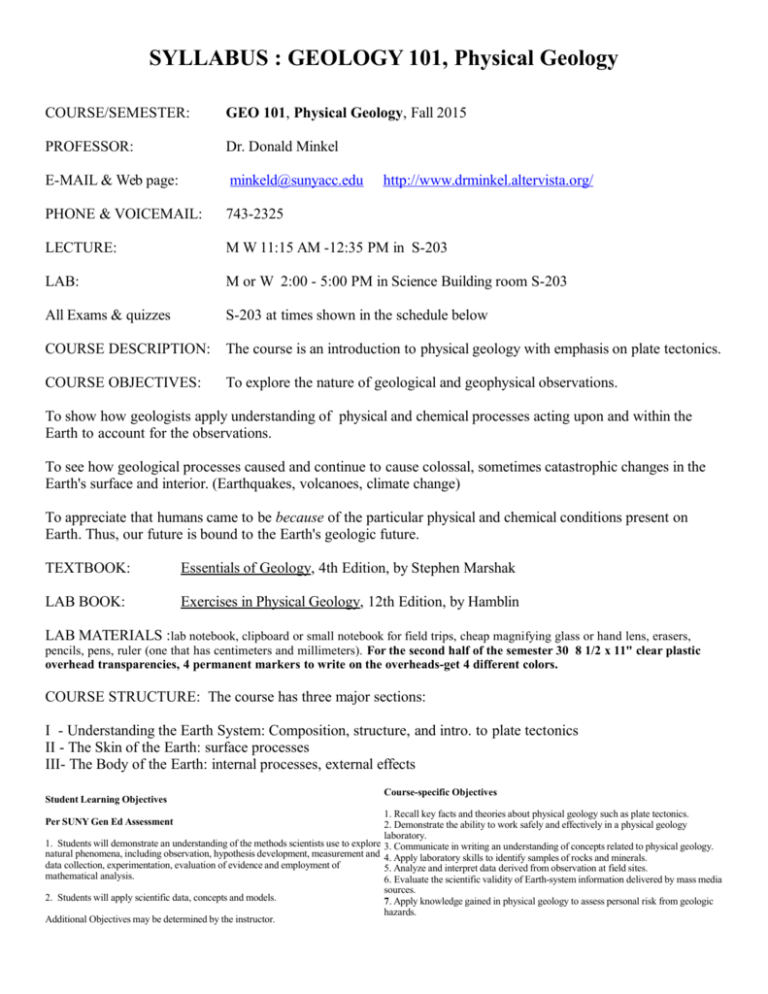
SYLLABUS : GEOLOGY 101, Physical Geology COURSE/SEMESTER: GEO 101, Physical Geology, Fall 2015 PROFESSOR: Dr. Donald Minkel E-MAIL & Web page: minkeld@sunyacc.edu PHONE & VOICEMAIL: 743-2325 LECTURE: M W 11:15 AM -12:35 PM in S-203 LAB: M or W 2:00 - 5:00 PM in Science Building room S-203 All Exams & quizzes S-203 at times shown in the schedule below COURSE DESCRIPTION: The course is an introduction to physical geology with emphasis on plate tectonics. COURSE OBJECTIVES: To explore the nature of geological and geophysical observations. http://www.drminkel.altervista.org/ To show how geologists apply understanding of physical and chemical processes acting upon and within the Earth to account for the observations. To see how geological processes caused and continue to cause colossal, sometimes catastrophic changes in the Earth's surface and interior. (Earthquakes, volcanoes, climate change) To appreciate that humans came to be because of the particular physical and chemical conditions present on Earth. Thus, our future is bound to the Earth's geologic future. TEXTBOOK: Essentials of Geology, 4th Edition, by Stephen Marshak LAB BOOK: Exercises in Physical Geology, 12th Edition, by Hamblin LAB MATERIALS :lab notebook, clipboard or small notebook for field trips, cheap magnifying glass or hand lens, erasers, pencils, pens, ruler (one that has centimeters and millimeters). For the second half of the semester 30 8 1/2 x 11" clear plastic overhead transparencies, 4 permanent markers to write on the overheads-get 4 different colors. COURSE STRUCTURE: The course has three major sections: I - Understanding the Earth System: Composition, structure, and intro. to plate tectonics II - The Skin of the Earth: surface processes III- The Body of the Earth: internal processes, external effects Student Learning Objectives Course-specific Objectives 1. Recall key facts and theories about physical geology such as plate tectonics. 2. Demonstrate the ability to work safely and effectively in a physical geology laboratory. 1. Students will demonstrate an understanding of the methods scientists use to explore 3. Communicate in writing an understanding of concepts related to physical geology. natural phenomena, including observation, hypothesis development, measurement and 4. Apply laboratory skills to identify samples of rocks and minerals. data collection, experimentation, evaluation of evidence and employment of 5. Analyze and interpret data derived from observation at field sites. mathematical analysis. 6. Evaluate the scientific validity of Earth-system information delivered by mass media sources. 2. Students will apply scientific data, concepts and models. 7. Apply knowledge gained in physical geology to assess personal risk from geologic hazards. Additional Objectives may be determined by the instructor. Per SUNY Gen Ed Assessment SEMESTER LAB, LECTURE, AND EXAM SCHEDULE Lab and lab book chapters Earth Revealed Video List Week First day of the week Textbook Chapter(s) 1 W 9/9 Preface, Prelude, 1 Videos: See Dr. Minkel's webpage 2 M 9/14 2, 3 Ch. 2 5. Birth of Theory 6. Plate Dynamics 12. Minerals 3 M 9/21 Interlude A & C, 4, 5 Ch. 3 14. Intrusive igneous Rocks 15. Volcanism 4 M 9/28 Interlude B, 6, 7 Ch. 4 15. Weathering and Soils 17. Sedimentary Rocks 5 M 10/5 7, Interlude B, review Ch. 5 18. Metamorphic Rocks 10. Geologic Time 6 M 10/12 Lec. Exam 1, M 10/12 Interlude E, 10, 11 Local Field Trip I 7 M 10/19 11, 9 Local Field Trip II 8 M 10/26 6 (weathering), 13 Lab exam 1 in lab: M or W 9 M 11/2 14, 16 7 10 M 11/9 16, 17 9, 10 Text: Interlude E 11 M 11/16 18 12, 13 Text chp. 18 12 M 11/23 Thanksgiving Week 13 M 11/30 14 M 12/7 15 M 12/14 Finals Week M 12/21 Review Lec. Exam 2, M 11/30 19, 8, Interlude D 8, Interlude D, 2 again! 2, Interlude D, review M 12/21 2:45-4:45 PM video: An Inconvenient Truth 16 18 - 22 Lab exam 2 in lab: M or W Study hard and plan ahead. Its comprehensive! Lecture or Lab Exam content 1. Down to Earth 2. The Restless Planet 11. Evolution Through Time Preface, textbook chapters 1-7, Interludes A & B 7. Mountain Building 8. Earth Structures 16. Mass Wasting Rock & mineral identification lab book chapters 2,3,4,&5 19. Running Water I 20. Running Water II 21. Ground Water 22. Wind, Dust, and Deserts 23. Glaciers 9. Earthquakes 3. Earth's Interior textbook chapters 9, 10, 12-18, Interludes D & E 4. The Sea Floor lab review sheet items, lab book chapters 7, 9,12,13,16, text ch.18 text chapters 2, 8,19, and Interlude C : 50%, all previous text chapters:50% Essentials of Geology, 4th ed. - contents Prelude: And Just What Is Geology? 1. The Earth in Context 2. The Way the Earth Works: Plate Tectonics 3. Patterns in Nature: Minerals Interlude A: Rock Groups 4. Up from the Inferno: Magma and Igneous Rocks 5. The Wrath of Vulcan: Volcanic Eruptions Interlude B: A Surface Veneer: Sediments and Soils 6. Pages of Earth’s Past: Sedimentary Rocks 7. Metamorphism: A Process of Change Interlude C: The Rock Cycle 8. A Violent Pulse: Earthquakes Interlude D: The Earth’s Interior Revisited: Insights from Geophysics 9. Crags, Cracks, and Crumples: Crustal Deformation and Mountain Building Interlude E: Memories of Past Life: Fossils and Evolution 10. Deep Time: How Old is Old? 11. A Biography of Earth 12. Riches in Rock: Energy and Mineral Resources Interlude F: An Introduction to Landscapes and the Hydrologic Cycle 13: Unsafe Ground: Landslides and Other Mass Movements 14. Streams and Floods: The Geology of Running Water 15. Restless Realm: Oceans and Coasts 16. A Hidden Reserve: Groundwater 17. Dry Regions: The Geology of Deserts 18. Amazing Ice: Glaciers and Ice Ages 19. Global Change in the Earth System Lab book contents – Hamblin & Howard – 12th edition page PREFACE 4 Exercise 1 MINERALS AND CRYSTAL GROWTH 6 2 MINERAL IDENTIFICATION 10 3 IGNEOUS ROCKS 24 4 SEDIMENTARY ROCKS 41 5 METAMORPHIC ROCKS 57 6 GEOLOGIC TIME-RELATIVE DATING 68 7 MAPS AND AERIAL PHOTOS 73 8 LANDFORMS OF THE UNITED STATES 92 9 STREAM EROSION AND DEPOSITION 97 10 MASS MOVEMENT 112 11 GROUNDWATER 116 12 VALLEY GLACIATION 125 13 CONTINENTAL GLACIATION 134 14 SHOREliNE PROCESSES 142 15 EOLIAN PROCESSES 155 16 STRUCTURAL GEOLOGY 162 17 SEISMOLOGY 190 18 PLATE TECTONICS 196 19 DIVERGENT PLATE BOUNDARIES 206 20 TRANSFORM PLATE BOUNDARIES 219 21 CONVERGENT BOUNDARIES 228 22 PLUMES AND HOTSPOTS 238 23 PLANETARY GEOLOGY 247 GRADING: Quizzes (first five minutes of every class, PLEASE BE ON TIME!) Remember the 2% deduction for missed labs or field trips! Exam I (M 10/12, Preface, textbook chapters 1-7, Interludes A & B) Exam II (M 11/30, textbook chapters 9, 10, 12-18, Interludes D & E ) Lab Exam I (rocks and minerals ID, in lab 10/26 or 10/28) Lab Exam II (lab review sheet items, lab book chapters 7, 9,12,13,16, text ch.18 in lab 12/14 or 12/16) Final Exam (text chapters 2, 8,12,19, and Interlude C :50%, all previous text chapters:50%) Final Exam: M 12/21 2:45-4:45 PM Total 15% 15 % 15 % 15 % 15% 25% 100 % QUIZZES: I will ask you one question about the reading assignment out of the textbook every time the lecture meets right at the start of the class. I will tell you which chapter to study during the previous class. If I forget just check the reading assignment in the schedule on the previous page. Each quiz will be graded as follows: 2 points - correct answer 1 point - incorrect answer 0 points - late for class and missed the quiz for no good reason 0 points - missed class for no good reason 0 points - left class early without speaking to Dr. Minkel before class as to reason quiz grade not counted - late for class or missed class for a good reason. When a quiz grade is not counted it means your grade is calculated as if that quiz hadn't happened. For example, if you had 35 out of 41 quizzes correct and missed 3 quizzes all for good reasons your quiz percentage for the semester would be (35x2 + 6x1)/(41x2), or 92.7%. If on the other hand your reasons aren't good, it would be (35x2 + 6x1)/(44x2), or 86.4%. Obviously, frequent missing of class and/or coming to class unprepared will result in a severe grade penalty!! Please be sure to write down and hand in the date of and good reason for a missed quiz. I am flexible about these but unless I get something written from you I will assume the reason wasn't good. The upshot of all this is: Come to class prepared, having read and studied the relevant text chapter. This, more than anything else, will help you to do well in this class. LAB AND FIELD TRIP ATTENDANCE: REQUIRED! Each unexcused lab or field trip absence reduces your semester quiz percentage by 2%. For example, the 86.4% calculated in the example above would go down to 82.4% if you missed a lab and a field trip without an excuse. Signed, dated, written excuses must be provided to avoid the penalty. Electronic interruptions in class/lab (cell phones etc.) Please disable any electronic noise making devices you have with you at the beginning of class or lab. Do not bring electronic devices to lecture exams or lab exams. * * * * * * ** Syllabus Statement: Under Section 504 of the Rehabilitation Act of 1973 and the Americans with Disabilities Act, a post-secondary student with a disability who is in need of academic accommodations or auxiliary aids is required to notify the College of the nature of the disability and to provide appropriate documentation which supports the request for reasonable accommodations or auxiliary aids. Individuals who would like to self-identify with a disability (and have not already) or think they may have a disability and want to request accommodations should contact the Accessibility Services Office located in Warren Hall or call (518) 7432282 (voice and relay) for an appointment. Dr. Minkel’s Schedule, Fall 2015 All main campus lectures and labs are in S-203. Astronomy lectures and labs are in Wilton 212 & Wilton 209. OFFICE HOURS ARE AS SHOWN in S-203/S-205 or Wilton 212 OFFICE HOURS are also available by appointment PHONE & VOICEMAIL: 743-2325 (rarely checked!) E-MAIL: minkeld@sunyacc.edu (frequently checked!) WEBSITE : http://www.drminkel.altervista.org/ MWF M TU W TH F TU/TH 8:00- 8:55 8:00- 9:00 9:05-10:05 9:00-10:00 10:10-11:05 10:00-10:55 11:15-12:35 Geo101 lecture Geo101 lecture 12:35- 2:00 Office S-203/S-205 Geo103 lecture Office S-203/S-205 Geo103 lecture 2:00-4:50 Geo101 lab Office Wilton 212 Geo101 lab Office Wilton 212 4:00 – 5:00 Ast113 Lec/lab 5:00 – 8:00 Ast113 Lec/lab 11:00-12:00 Faculty & Division Meetings 12:30 – 1:50 All main campus lectures and labs are in S-203. Astronomy lectures and labs are in Wilton 209 & Wilton 212.

